Harnessing Integration Platforms To Unscramble the Data Mess
This article discusses the roadmap to choose your data partner and further reviews leading data integration platforms.
Join the DZone community and get the full member experience.
Join For FreeData powers enterprise success, but integrated data ensures it happens sooner. That’s why businesses flock to data management platforms for a comprehensive top view of their customers, operations, and partners. This enables them to make informed decisions, improve efficiency, and produce smarter insights. Easily explains why the data integration market is expected to grow at a CAGR of more than 10% from 2023 to 2032.
While many data integration tools exist in the market, only a few excel in providing adaptability per modern businesses' needs.
Integration systems enable research and analytics teams to capture data from different sources and harmonize it to derive actionable insights. If you have just started your journey into data integration, this blog navigates you through the nitty gritty.
This post discusses the roadmap to choose your data partner and further reviews leading data integration platforms.
A robust integration platform enables enterprises to collect, process, and utilize data from sources, thereby improving decision-making and operational efficiency. While choosing a data integration partner, consider the following key parameters.
- Start with evaluating the dataset's characteristics; volume, variety, and velocity. Since different integration platforms come with varying expertise, finding common ground with the enterprise’s requirements is essential.
- Next, check for the considered platform’s scalability quotient. An enterprise’s growing operations mean an increase in data source points and a further increase in integration requirements. This is important to avoid any chances of migrations and disruptions in the future.
- For an overarching performance, the platform should be flexible with different types of data sources and formats. An adaptable platform ensures no valuable information is missed.
- As always highlighted in all other posts, security and regulatory compliance are paramount with data products. Given stringent enforcements from GDPR and others, the integration platform should adhere to the policies, especially when handling personal and financial data.
While we are at it, finding a common ground between affordability and functionality is important. Do a thorough assessment of the planned investment alongside concurrent operational expenses.
To better understand the parameters discussed, let's review the most talked about data integration platforms in the market.
A cloud-based data integration platform that I have used is called Skyvia, which offers a wide range of features for businesses of all sizes. It is a powerful tool for ETL, ELT, reverse ETL, data migration, one-way and bi-directional data sync, workflow automation, and more.
Skyvia's drag-and-drop interface makes creating and managing data pipelines easy, even for users with no coding experience. It also offers a wide range of pre-built connectors for popular cloud and on-premises data sources, making it easy to get started quickly.
One of the things that sets their solution apart from other data integration solutions is its flexibility. It can solve many data integration challenges, from simple one-time migrations to complex enterprise-grade data pipelines.
Comparing Leading Data Integration Platforms
While there’s a line-up of suitable platforms, the below five tools excel favorably on many parameters. Apart from being immensely user-friendly, they are cost-effective and support a diverse system landscape.
Here is a comparison of leading data integration tools:

Checking Out the Unique Value Proposition of Data Integration Platforms
A widespread cloud-based data integration platform successfully addresses common integration challenges in the cloud, on-premise, and hybrid environments. They work with all types of data sources, thereby breaking down system barriers and increasing the scope of integration. Skyvia scores well on all major parameters, as discussed previously. It ensures total compliance of masked data sets with regulations such as the GDPR and cleanses the data in transit.
Businesses can seamlessly maintain cross-system consistency and accuracy with such hassle-free data synchronization. Not to miss, these data integration tools automate features and optimize time and resources.
How Can Cloud Data Integration Solutions Solve Common Data Integration Problems?
A retail system landscape, for example, can integrate its e-commerce platform, PoS system, and inventory management. This provides an on-demand overview of customer, sales, and inventory data.
Likewise, a healthcare system can integrate patient records and billing systems with them. It simplifies the processes and enhances the care delivery to patients.
A financial services company can integrate their CRM, trading, and risk management systems into the platform. This results in better risk identification, compliance management, and overall customer experience.
The immensely user-friendly interface of these widespread data integration platforms makes them adaptable, eliminating the need for tech expertise to perform complex actions. Below is a quick glimpse of the platform’s dashboard.
Unscrambling the Data Chaos
Data is not just about power; it's about empowerment. In pursuing the same, data management systems empower organizations to test uncharted waters confidently and tap into limitless possibilities. Given the exponential growth of the data integration market, businesses will have more options to overhaul their pipelines and build and achieve in-the-moment and smarter insights. Which data integration platform are you using?
Opinions expressed by DZone contributors are their own.

Comments